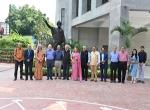The Vivekananda International Foundation (VIF) hosted Prof Tai Ming Cheung, an Associate Professor at the School and Director of the Institute on Global Conflict and Cooperation (IGCC), University of California. The talk was on ‘Understanding China's Progress in the Development of its Defence and Strategic Science, Technology and Innovation Capabilities’. Dr Arvind Gupta, Director VIF, presided over the session and delivered the opening remarks. Members of the strategic community, including Dr. Devendra Kumar, Amb. Kanwal Sibal, Vice Admiral Raman Puri, Amb. Dinkar Srivastava, Amb. Satish Chandra and Prof. Sujit Dutta attended the deliberations.
Prof. Tai gave an outline of China’s science and technological (S&T) development. China’s twenty-first-century defence model, as yet is an ‘absorptive statist’ framework of development. It is a model based on four steps: introduce, digest, assimilate and re-innovate (IDAR) to absorb the technology. The most relevant example of the model is the Chinese high-speed railways where technology was provided by Germany, Japan, France and Canada. It is also a statist model which implies that it follows is a state-led, top-down framework. The state in terms of its agencies and the State-owned enterprises (SOE) play a dominant role in the process.
The Prof. further expounded on the major challenge for China to move away from an ‘absorptive statist’ model to an innovation-led model. If China moves to an innovation-led model it will have to give a greater role to market forces to overcome compartmentalisation. Xi Jinping has indicated in his various speeches that China will be moving towards an innovation-led model. He reiterated it during the 19th National Congress of the Communist Party of China. In 2016, Xi Jinping had presented the grand vision of greater civil-military fusion and indicated that China will be driven by the Innovation Driven Development Strategy (IDDS). The White paper on IDDS was released in May 2016. The vision is to be interpreted in three phases: first, a innovative country by 2020; second, to move to the forefront of innovation by 2030 (this was adjusted to 2035 during the 19th National Congress of the Communist Party of China); and third, to challenge the US for global leadership by 2050.
Prof. Tai explained the key feature of the IDDS model. The prime objective of the IDSS model is to make China a strong science and technological power but there is a need to reorganise quantity into quality and achieve grand projects. China no longer has the aim to catch-up with any country, rather it is looking forward to playing a central role, he argued. It is aiming at making a breakthrough in the science and technology (S&T). A great deal of strategic high-technology research in China is to ensure that defence and dual-use innovations remains the top priority. Major research is already going on in the field of deep-sea, aeronautics and quantum communication. Further, to ensure that the civil and military dimensions of S&T developments do not distract the focus from civil-military integration. Notably, the process of civil-military integration was initiated by Jiang Zemin. In 2015, Xi Jinping elevated it to the national level from the ministerial level, with him heading the Commission of Civil-Military Development.
In summary, Prof. Tai illustrated that China’s S&T model is pivoting towards an advanced innovation model. A number of organisations are dedicated towards it; China’s Central Military Commission on S&T was established on January 2016. It is an agency similar to the Defence Advanced Research Project Agency (DAPAR) of the US. Main role of the Commission is to tap into universities to engage and direct them towards technology development. Additionally, there are many medium to long-term defence plans and programmes dedicated for this role. By 2020, there will be clarity whether China is ready for a take-off or not.
Discussions were held on the programmes and plans initiated by China to increase its human resources on S&T. China has initiated programmes such as ‘985’, ‘863’ and ‘ten thousand’ to get the best trained personnel and scientific manpower. Ties between academia and industries have been strengthened. Chinese companies are investing in the research laboratories in universities.
Deliberations were held on the funding of the projects and the progress in S&T. Besides the government support, the Chinese venture and private companies have invested in the S&T projects. On Artificial Intelligence (AI), the US has a head start but China has an edge in terms of ‘data’ as compared to any other countries. The Chinese Government has invested heavily in AI and this has become its top priority. On Quantum Communication, China has achieved much more than the US. There appears to be a beginning of a dual technological order; one led by the US and its allies and the other by China. This represents a fundamental shift in the global technological order.
In conclusion, it was reiterated that under Xi Jinping, the civil-military integration is going to gain momentum.








Post new comment